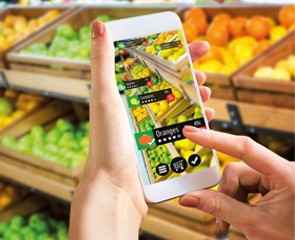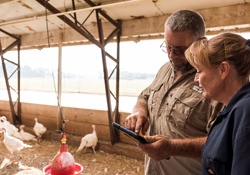From farm to table: supply chain digitalization at Cargill

In an example of how food processors and manufacturers are catering to consumer desire for increased food supply chain transparency, Cargill is piloting a blockchain-based, farm-to-table traceability program on select Honeysuckle White turkeys this Thanksgiving season.
The push for food supply chain transparency

Additionally, regulatory bodies are also pushing for increasingly transparent food supply chains given that applying higher standards to food production supply chain information collection and management can reduce the impact animal disease has on global food production and ultimately have huge public health benefits [3].The US Centers for Disease Control and Prevention estimates that, each year, roughly one in six Americans get sick, 128,000 are hospitalized and 3,000 die from food-borne diseases [4]. Case in point, a 2015 E.coli outbreak at Chipotle Mexican Grill left 55 customers ill and, unable, to monitor its suppliers in real time, Chipotle could neither prevent the contamination nor contain it in a targeted way after it was discovered [5].
Unfortunately, although it is essential to understand the supply chain to meet federal regulations, mitigate risks, and satisfy consumer demands for supply chain transparency, many food manufacturers find it difficult to document their end-to-end supply chains [6].
Cargill launches traceability pilot

This pilot also marks Cargill’s first to-market, blockchain-based solution. Cargill Chief Information Officer Deb Bauler explains that “the blockchain model builds a trusted, transparent food chain that integrates key stakeholders into the supply chain and creates a distributed ledger with immutable records. Because all participants inside the blockchain network must agree before a new record is added to a ledger, the technology also reduces the risk of fraud or human error, and cryptography within the network ensures security, authentication and integrity of transactions” [7]. By digitally recording the identity of goods, blockchains can provide a permanent, immutable record for every food ingredient as it travels from farm to table. This transparency gives processors, like Cargill, and the other stakeholders further downstream (e.g. wholesalers, distributors, consumers, etc.) information about where their food comes from, how it was processed, and a full accounting of its movement along the supply chain [9].
What next?
The aforementioned pressures are likely to only keep intensifying which implies that this is an issue that Cargill, and many other food processors and manufactures, will be forced to confront in the foreseeable future. Going forward, one of the key challenges to be addressed is how to efficiently and effectively implement these traceability measures at scale. Food supply chain systems are complex, dynamic, multi-party arrangements, with regulatory and logistical constraints which often cross jurisdictional boundaries [10] and the addition of track and trace technologies will require regular verification procedures to ensure ongoing compliance. Extensive collaboration and cooperation will be necessary to ensure these systems operate effectively across the entire chain. Cargill will need to motivate (and possibly support) upstream and downstream supply chain partners to connect and integrate the track and trace technologies as well as to ensure that all members of the chain understand the risks associated with a safety failure [11]. Moreover, given its extensive product portfolio, Cargill will likely be forced to selectively pursue this at-scale food blockchain implementation. Additionally, Cargill will need to address potential scalability and confidentiality issues stemming from the use of blockchain technology. For example, many private blockchains (which is what Cargill would presumably use) share information among all participating nodes. This is ok for a fully vertically integrated solution, but, if competitors are present on the same blockchain, they may be able to discover information that is normally held commercial-in-confidence [12].
Ultimately, while challenges like this will require time and resources to resolve, the potential upsides of realizing a completely transparent, end-to-end food supply chain justify the investment.
(790 words)
References
- Strothkamper, A. “Farm to Fork Goes Digital: How Agribusiness Digitzation Can Feed the World.” Digitalist Magazine. (September 7, 2016).
- “Ikea pulls elk lasagna found to contain pork.” BBC News. (April 6, 2013).
- Thompson, S. “From trough to table: mapping the food chain saves lives.” The Guardian. (January 16, 2015).
- “Burden of Foodborne Illness: Overview.” The Centers for Disease Control and Prevention. (July 15, 2016).
- Casey, M and P Wong. “Global Supply Chains Are About to Get Better, Thanks to Blockchain.” Harvard Business Review. (March 13, 2017).
- “Food Safety Supply Chain Risk Management,” Deloitte Perspectives. (2017).
- “Honeysuckle White brand leads the way in Food Transparency, Delivering a farm-to-table Thanksgiving Featuring First-ever Traceable Turkeys.” Cargill Inc. (Oct. 25, 2017).
- “Traceable turkeys mark Cargill’s entry in farm-to-Thanksgiving-table project.” The Japan Times. (October 27, 2017).
- Maras, E. “From farm to table: How blockchain benefits food supply chains.” Blockchain Tech News. (May 8, 2017).
- Hughes, A. “Getting Food and Drink to the Table Digitally.” GE Digital Insights.
- “The food value chain: A challenge for the next century,” Deloitte Perspectives. (2017).
- Staples, M., Chen, S., Falamaki, S., Ponomarev, A., Rimba, P., Tran, A. B., Weber, I., Xu, X., Zhu, J. “Risks and opportunities for systems using blockchain and smart contracts.” Commonwealth Scientific and Industrial Research Organisation (May 2017).
- Fernandez, A. “Supply Chain Transparency in the Age of Digital and Physical Convergence.” Food Quality & Safety. (June 24, 2016).



Thanks for the interesting read! The move towards a more transparent supply chain makes a lot of sense though I’m surprised to see food manufacturing pursue this given, as you mention, the complexity and multi-party arrangements coupled with regulatory constraints in this industry. However, I think it’s a very smart move and I wonder what impact this will have on smaller, local producers. There has been a growing trend towards locally sourced meat products (partly due to the call for greater transparency). Will this move reduce the transparency gap and push out local producers or even incorporate them as partners into the supply chain? It’s definitely a great way to innovate and anticipate future trends, though per your point, scalability of this model is still TBD.